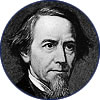Elias Loomis
1811–1889 B.A. 1830
|

|
The annals of meteorological research in the 19th century reflect a series of contributions by American astronomer Elias Loomis. He is credited with, among other observations, clarifying the effects of air temperaturesparticularly converging warm and cold currentson the formation of fog and precipitation.
Students of nature in Loomis’s day had to trace a circuitous path starting in the more traditional curriculum; in his case, this meant theological studies and the teaching of Latin. But Loomis soon moved into mathematics and “natural philosophy” while he fine-tuned his skills of observation. Besides meteorology, he earned a reputation through published reports on shooting stars, the declination of the magnetic needle, and the path of Halley’s comet (1835).
Loomis pioneered the depiction of weather phenomena on maps and influenced the creation of the National Weather Service in 1869. After teaching at Western Reserve College, New York University, and Princeton, he joined the Yale faculty in 1860. The $300,000 that Loomis bequeathed to the University came in large part from the more than half-million of his textbooks on mathematics, general science, astronomy, and meteorology that were sold over the years.
Students recalled him as “mathematics personified,” referring to his minute consistency in everything, and maintained that “it was the easiest thing in the world to imitate his angular manner.”

